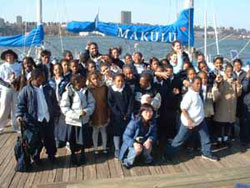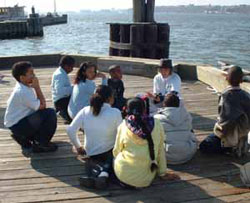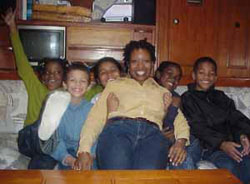Reach the World
As a young girl, Heather Halstead dreamed of sailing around the world on her own ship. Sailing was something her father and grandfather enjoyed doing, and Halstead had both attended and taught at a summer sail training program for teenagers.
Halstead was preparing to graduate from Dartmouth, where she was studying history and education, when she decided she wanted her teaching experience to be in a non-traditional environment. That, plus her desire to sail around the world, sparked the idea for Reach the World-a program in which a 43-foot Nautor Ketch sailboat, Makulu II, brings a crew of educators around the world to work on projects for a network of elementary and middle school classrooms. The students and the crew connect on a regular basis through the Internet and by e-mail.
"The first voyage," she said, "was a personal adventure between friends." On the first sail, Halstead and her friend Mark Gustafson were co-captains for two years with various crew members who came and went over the course of the voyage. At that time, Halstead had been introduced to Josh Reibel, former associate director of TC's Institute for Learning Technologies (ILT), who was involved with schools that were being wired for technology through the Eiffel Project. Each filled a need for the other-Halstead was looking for schools to work with, and Reibel needed technology-based projects for teachers. Three of those schools were chosen to collaborate with the crew of the boat. (See Inside TC January 22, 1998, for an article on that project).
That voyage was basically a virtual experience, said Halstead, offering students no hands-on opportunities with the crew or the vessel, which left from Florida for a sail around the world. "We were able to add a hands-on element this fall with classrooms in New York City," she said. A group of students whose class is collaborating on the second project was able to come into Manhattan to meet the crew at the 79th Street Boat Basin and learn about map reading, knot tying and other skills used by crew members. "It was the first time some were on the Hudson River or on a ship," Halstead said.
The second voyage, which began in November 2001, involves 25 schools from under-resourced New York City public school districts. Students and teachers in these classrooms work with interns supervised by ILT who assist teachers in the design, development and implementation of curriculum for the project.
"A lot of graduate students who have not been teachers come wanting to do instructional technology," said Shawna BuShell, Intern Coordinator at ILT. "This gives them exposure to the classroom and how to integrate technology with what is being done in the classroom."
Each class creates one major project that the crew researches for them.
Stacia McFadden is an intern who works with six classroom teachers at CES 70 in the Bronx. One class that she is working with is doing a comparative study of fourth graders around the world. "We did a video to show other kids in schools," she said. "We took photos of text books and sample tests. When the crew is in other countries, they take photos of kids in those schools. This is like a real living textbook in 2002."
Before returning to graduate school at TC, McFadden worked at IBM teaching workshops. Now, as an intern she is using what she learned in corporate America and bringing it to the classroom. "I was already familiar with training people to use technology," she said. "Now it's with kids instead of executives." McFadden hopes to eventually develop an after-school technology enrichment program.
A Web site for the project, www.reachtheworld.org, chronicles a growing archive of curriculum resources that teachers have suggested the crew research in ports of call. "It's a collection of resources about the world in real time that anyone can access," Halstead said. The interactive part of the site consists of the field notes-documents that the crew creates about topics ranging from marine life to transportation, water quality or food in other countries.
Interns are paid by Reach the World for two credits toward their degree, which amounts to an average of $10 per hour. "Two years ago we had internships with no pay," BuShell said. Funding for the project comes from a number of NewYork City-based foundations, with money for the collaboration with TC coming from the Christian A. Johnson Endeavor Foundation. There are also individuals who are friends of the Reach the World campaign who sponsor individual schools. "We're trying to raise money to support a TC evaluation group that would help us determine how to make this better," Halstead said. "We need to quantify the evidence that will allow the Makulu project to continue for another four years."
Published Friday, May. 3, 2002


